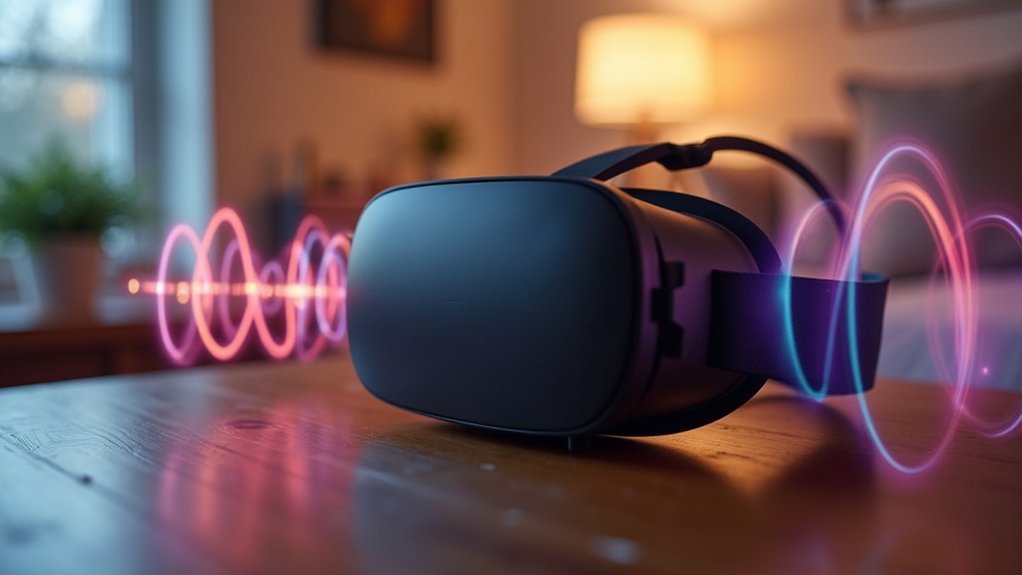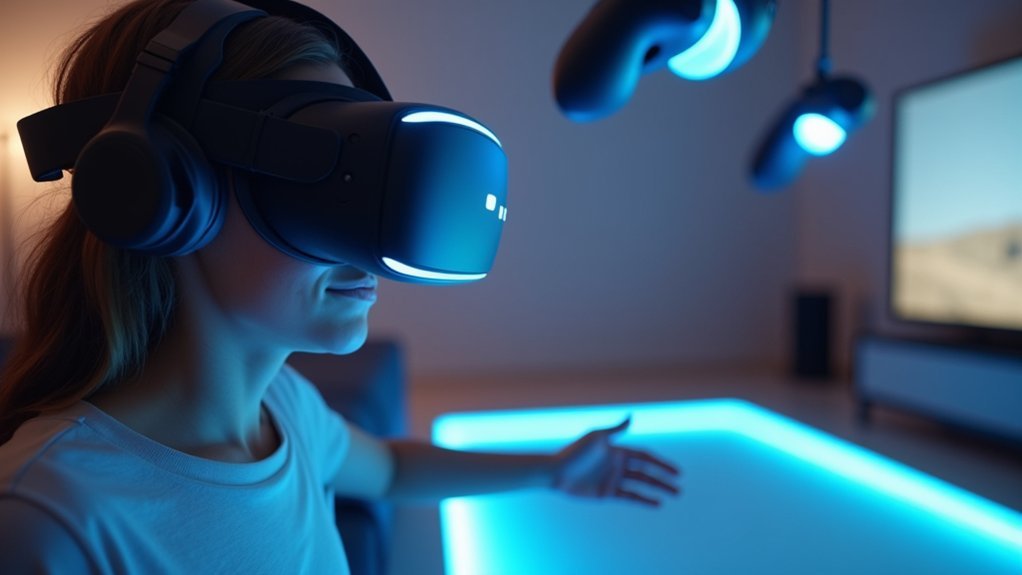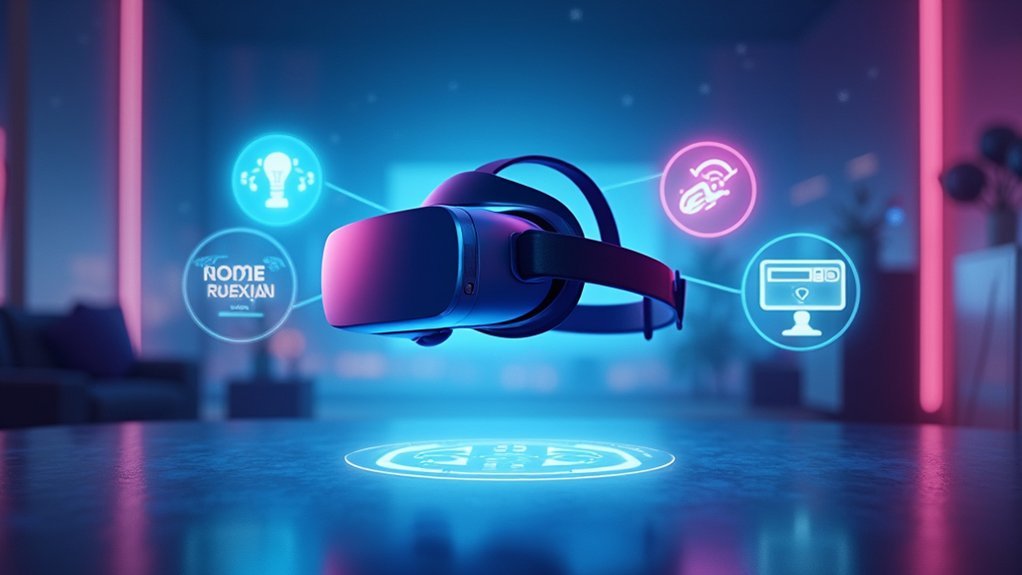You’ll experience true VR freedom with the Oculus Quest’s wireless 6DOF tracking, eliminating cables while maintaining precise movement detection. The headset streams PC VR games wirelessly through Virtual Desktop, delivers spatial audio without external headphones, and runs on the powerful Snapdragon XR2 processor. Guardian boundaries keep you safe, passthrough cameras show real-world obstacles, and you can set up anywhere without base stations. Social VR experiences and over-the-air updates expand your possibilities even further.
Untethered 6DOF Movement and Tracking Freedom

When you put on the Oculus Quest 2, you’ll immediately notice the freedom that comes with its six-degrees-of-freedom tracking system. This untethered experience lets you move naturally in three-dimensional space without external sensors or cables restricting your movements.
The built-in Oculus Insight tracking utilizes internal sensors to map your play area and monitor your head and hand positions in real time.
Real-time sensor mapping delivers precise head and hand tracking for seamless virtual reality immersion.
The wireless functionality transforms your VR sessions by eliminating cable management concerns. You can duck, dodge, and explore virtual worlds without tripping hazards.
The Guardian system enhances this 6DOF freedom by creating virtual boundaries that alert you when approaching your play area’s edges. This tracking technology performs reliably across various lighting conditions, ensuring consistent wireless gameplay whether you’re in bright rooms or dimmer environments.
Wireless PC VR Streaming via Oculus Link and Virtual Desktop
You can transform your Quest headset into a wireless PC VR powerhouse through two primary methods: Oculus Link’s cable connection and Virtual Desktop’s Wi-Fi streaming solution.
Setting up Oculus Link requires a USB-C cable to your VR-ready PC, delivering high-fidelity visuals with minimal latency for accessing your entire PC VR library.
Virtual Desktop offers true wireless freedom, but you’ll need a robust Wi-Fi connection to achieve peak performance and maintain smooth, responsive gameplay.
Oculus Link Cable Setup
While the Oculus Quest excels as a standalone VR headset, connecting it to a VR-ready PC opens up an entirely new dimension of gaming possibilities through Oculus Link functionality.
You’ll need a USB-C cable that supports USB 3.0 for peak performance between your Quest 2 or Quest 3 and gaming PC.
Setting up Oculus Link requires:
- A compatible USB-C to USB 3.0 cable for reliable data transfer
- VR-ready PC with sufficient processing power and graphics capabilities
- Oculus PC software installed and updated to latest version
For wireless streaming alternatives, Virtual Desktop offers untethered gameplay when you’ve got a robust Wi-Fi 6 connection.
You’ll experience seamless changes between standalone and PC VR experiences, accessing broader game libraries while maintaining the Quest’s portability advantages.
Virtual Desktop Wi-Fi Performance
Performance benchmarks reveal that Virtual Desktop’s Wi-Fi 6E integration transforms wireless PC VR streaming into a legitimate alternative to wired connections.
You’ll experience dramatically reduced latency compared to previous wireless generations, with Quest 3 users consistently reporting near-wired performance levels. The wireless connection quality becomes exceptional when you’re using a dedicated router optimized for VR streaming demands.
Virtual Desktop’s AV1 codec support delivers superior video compression, enabling higher resolution visuals with minimal stuttering during your PC VR sessions.
You won’t need to sacrifice visual quality for wireless freedom anymore. The enhanced specifications create an immersive gaming experience that eliminates cable constraints while maintaining the performance standards you’d expect from wired connections.
This makes Quest 3 your ideal choice for untethered PC VR gaming.
Built-in Spatial Audio Without External Hardware

Immersion reaches new heights when the Oculus Quest 2’s built-in spatial audio eliminates your need for external headphones or bulky audio equipment.
The integrated audio system delivers an immersive sound experience through dynamic rendering that creates realistic surround sound effects during gameplay.
You’ll appreciate how the built-in speakers provide high-quality sound without adding pressure to your face, ensuring comfort during extended sessions.
The system’s design enhances virtual environments while maintaining the headset’s wireless freedom.
Key audio advantages include:
- Dual 3.5mm jacks – Connect personal audio options when you prefer private listening
- Dynamic sound rendering – Experience directional audio that responds to your movements
- Pressure-free design – Enjoy extended gameplay without additional facial discomfort
This audio performance has earned positive reception, creating more engaging and lifelike experiences across games and applications.
Standalone Processing Power With Snapdragon XR2 Chip
You’ll experience console-quality gaming without needing a PC or external hardware thanks to the Quest 2’s Snapdragon XR2 processor.
This dedicated mobile VR chip delivers 50% better CPU performance and twice the GPU power compared to the original Quest, enabling smoother frame rates and enhanced graphics.
The XR2’s processing capabilities let you run demanding VR applications independently while maintaining the wireless freedom that makes standalone headsets so appealing.
XR2 Performance Capabilities
At the heart of the Quest 2’s wireless freedom lies the Snapdragon XR2 chip, delivering standalone processing power that eliminates your dependency on external computers or gaming consoles.
This advanced processor transforms your VR experience through significant performance optimization across multiple areas.
The XR2 chip enables three key performance capabilities:
- Enhanced Visual Quality – Supports high-resolution displays at 1832 x 1920 pixels per eye, dramatically reducing screen door effects while delivering crisp text clarity
- AI-Powered Interaction – Powers controller-less hand tracking features, allowing natural gesture controls without traditional hardware
- Smooth Gaming Performance – Combined with 6GB RAM, maintains consistent frame rates for graphically demanding applications and immersive gaming experiences
You’ll notice improved visual fidelity and responsiveness that makes standalone VR genuinely competitive with tethered systems.
Mobile VR Processing
The Snapdragon XR2’s mobile processing architecture fundamentally changes how you experience VR by bringing desktop-class performance to a completely wireless form factor.
Your Oculus Quest 2 delivers remarkable standalone capabilities that eliminate dependency on external hardware while maintaining exceptional visual quality.
The Snapdragon XR2 processor powers demanding applications with 6GB of RAM, ensuring smooth multitasking during intensive gameplay.
You’ll experience high-resolution graphics that rival tethered systems, supported by advanced 3D spatial audio for complete immersion.
The chip’s enhanced machine learning capabilities enable precise hand tracking and sophisticated environmental mapping, creating more intuitive interactions.
Mobile VR reaches new heights through wireless PC gaming via Oculus Link, expanding your content library seamlessly.
The XR2’s processing power transforms portable VR from a compromise into a premium experience that matches traditional setups.
Guardian Boundary System for Safe Wireless Play

When you’re immersed in virtual reality, maintaining awareness of your physical surroundings becomes essential for safe wireless gameplay. The Guardian boundary system automatically maps your play area using built-in sensors that uphold effective tracking in various lighting conditions.
This tracking system lets you define safe zones to prevent collisions with real-world objects during wireless sessions.
You’ll appreciate these key Guardian features:
- Multiple play spaces – Set up to five distinct configurations that the system remembers for future use
- Automatic boundary loading – Previously defined spaces activate seamlessly when you re-enter them
- Visual and auditory alerts – Virtual walls provide clear cues when you approach boundaries
These safety measures guarantee your immersive gameplay remains both thrilling and secure throughout extended wireless sessions.
Controller-Free Hand Tracking Technology
You’ll experience the ultimate wireless freedom when you drop the controllers entirely and use your bare hands to navigate virtual worlds.
The Quest’s hand tracking technology recognizes your natural gestures, letting you pinch, point, and grab objects just like you’d in real life.
This controller-free approach creates an incredibly immersive gaming experience where your hands become the primary interface for interaction.
Natural Hand Gestures
While traditional VR controllers offer precise input, Oculus Quest’s controller-free hand tracking technology transforms how you interact with virtual environments by recognizing your natural hand gestures directly.
Multiple cameras capture your hand movements in real-time, creating an intuitive and immersive experience that feels remarkably natural.
You’ll find hand tracking enhances interaction through:
- Pinch gestures – Select menu items and pick up virtual objects with thumb-to-finger movements
- Grab motions – Hold and manipulate items using your full hand for realistic object handling
- Swipe controls – Navigate interfaces smoothly by moving your hand across virtual surfaces
This controller-free approach works across social apps, games, and productivity tools, making VR more accessible.
The technology continues improving through software updates, delivering increasingly precise hand tracking that responds naturally to your movements.
Controller-Free Gaming Experience
Gaming with hand tracking on the Oculus Quest takes this controller-free technology beyond simple menu navigation and transforms your entire gameplay experience.
You’ll discover that multiple onboard cameras capture your hand movements with remarkable precision, letting you pinch, swipe, and interact naturally within the virtual environment. This immersive experience eliminates the hassle of batteries while giving you complete freedom of movement during gameplay.
The technology seamlessly integrates with existing Quest titles, allowing smooth shifts between traditional controllers and intuitive gaming with your bare hands.
You’ll find that controller-free interaction enhances social experiences and makes gaming more accessible. Hand tracking creates a truly natural connection between your physical movements and virtual actions, delivering an unprecedented level of immersion.
Passthrough+ Camera for Real-World Awareness
When traversing virtual worlds becomes second nature, the Passthrough+ camera system on the Oculus Quest 2 guarantees you don’t lose touch with reality.
This enhanced passthrough technology delivers color vision and improved depth perception, transforming how you interact with your physical environment during VR sessions.
The upgraded system greatly boosts your real-world awareness and spatial awareness while maintaining immersion.
You’ll appreciate these key advantages:
- Instant environment switching – Press a button to seamlessly toggle between VR content and your surroundings
- Enhanced safety setup – Establish play boundaries without removing your headset
- Accident prevention – Navigate confidently around obstacles and furniture
While the Guardian system operates more restrictively than previous models, Passthrough+ effectively compensates by keeping you connected to your physical space, ensuring safer and more confident VR experiences.
Portable Setup in Any Location Without Base Stations
Where can you experience premium VR gaming when you’re not tethered to a computer or external sensors?
With the Quest 2’s portable setup, you can transform any space into your virtual playground. The wireless setup eliminates base stations entirely, letting you pack the lightweight 571g headset into a messenger bag and go anywhere inspiration strikes.
Quest 2’s wireless freedom turns any room into your personal VR playground without external sensors or base stations.
The internal tracking system delivers six-degrees-of-freedom movement while Guardian space technology maps your real world boundaries using built-in sensors.
You’ll need just 6.5 by 6.5 feet and 75 seconds to establish your play area, whether you’re in a friend’s living room, hotel, or outdoor location.
This freedom means spontaneous VR sessions become reality, breaking the traditional barriers that kept virtual experiences confined to dedicated gaming rooms.
Wireless Social VR Experiences and Facebook Venues
Beyond gaming capabilities, the Quest 2’s wireless freedom opens up immersive social connections through Facebook Venues.
You’ll discover a platform where wireless capabilities enable untethered participation in live concerts, events, and social gatherings alongside friends and strangers in shared virtual spaces.
Facebook Venues transforms your social experience through:
- Real-time interactions – Chat, react, and share moments during live events with enhanced presence
- Avatar customization – Create personalized representations that foster genuine connections with other users
- Seamless integration – Leverage Quest 2’s wireless design for completely untethered social experiences
You can attend virtual concerts, participate in community events, and engage with others without external hardware limitations.
The platform continuously evolves with regular updates, introducing new features that enhance social interaction and user engagement in VR environments.
Over-the-Air Software Updates and Feature Additions
Since the Quest 2 connects wirelessly to the internet, you’ll receive automatic over-the-air updates that continuously enhance your headset’s performance and capabilities.
These updates greatly improve visual fidelity through enhanced refresh rates and resolution adjustments, making your games run smoother with better graphics. You’ll constantly discover new game releases and software optimizations that expand your available titles while improving gameplay experiences.
Previous updates have introduced revolutionary features like hand tracking, letting you interact naturally without controllers.
The Guardian boundary system has also received considerable improvements, making room-scale VR safer and more intuitive. You won’t need to manually install software or connect to computers—everything happens seamlessly in the background.
This continuous evolution guarantees your Quest 2 stays cutting-edge, delivering fresh features and enhanced performance long after your initial purchase.
Frequently Asked Questions
Is Wifi 5 Good for Meta Quest 3?
You’ll find Wi-Fi 5 works for basic Meta Quest 3 gaming, but you won’t get ideal performance. You’ll experience higher latency and potential stuttering compared to Wi-Fi 6E’s superior bandwidth.
What’s the Difference Between the Different Oculus Models?
You’ll find the original Quest offers basic VR, Quest 2 adds better resolution and wireless PC gaming, while Quest 3 delivers the best experience with Wi-Fi 6E and pancake lenses.
What Wi-Fi Is Best for VR?
You’ll want Wi-Fi 6E for the best VR experience. It operates on 6GHz, providing faster speeds and lower latency under 20ms. You’ll get reduced interference and smoother gameplay compared to older standards.
What Is the Best Oculus Quest to Get?
You’ll want the Quest 3 if you’re prioritizing cutting-edge wireless performance and social experiences. However, if you’re budget-conscious, the Quest 2 offers excellent value with solid performance at $299.
In Summary
You’ve got incredible wireless freedom with the Oculus Quest that’ll transform your VR experience. You’re no longer tied down by cables or limited to one room – you can play anywhere while staying safe with Guardian boundaries. You’ll enjoy PC-quality games wirelessly, immersive spatial audio, and seamless social experiences. With regular updates adding new features, you’re investing in a headset that keeps getting better without any additional hardware requirements.





Leave a Reply